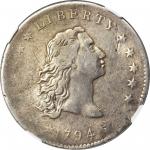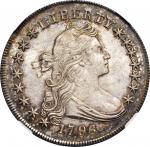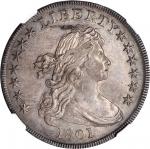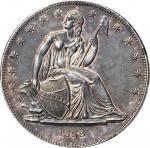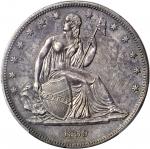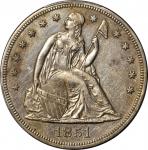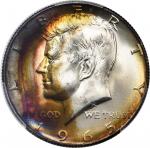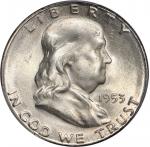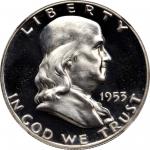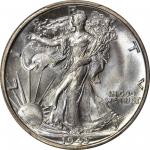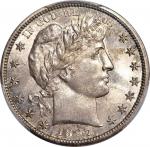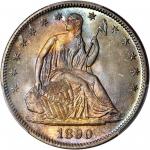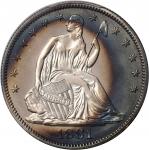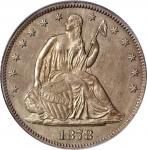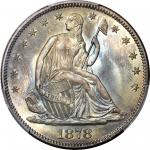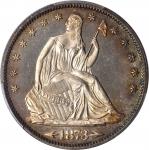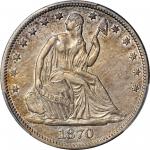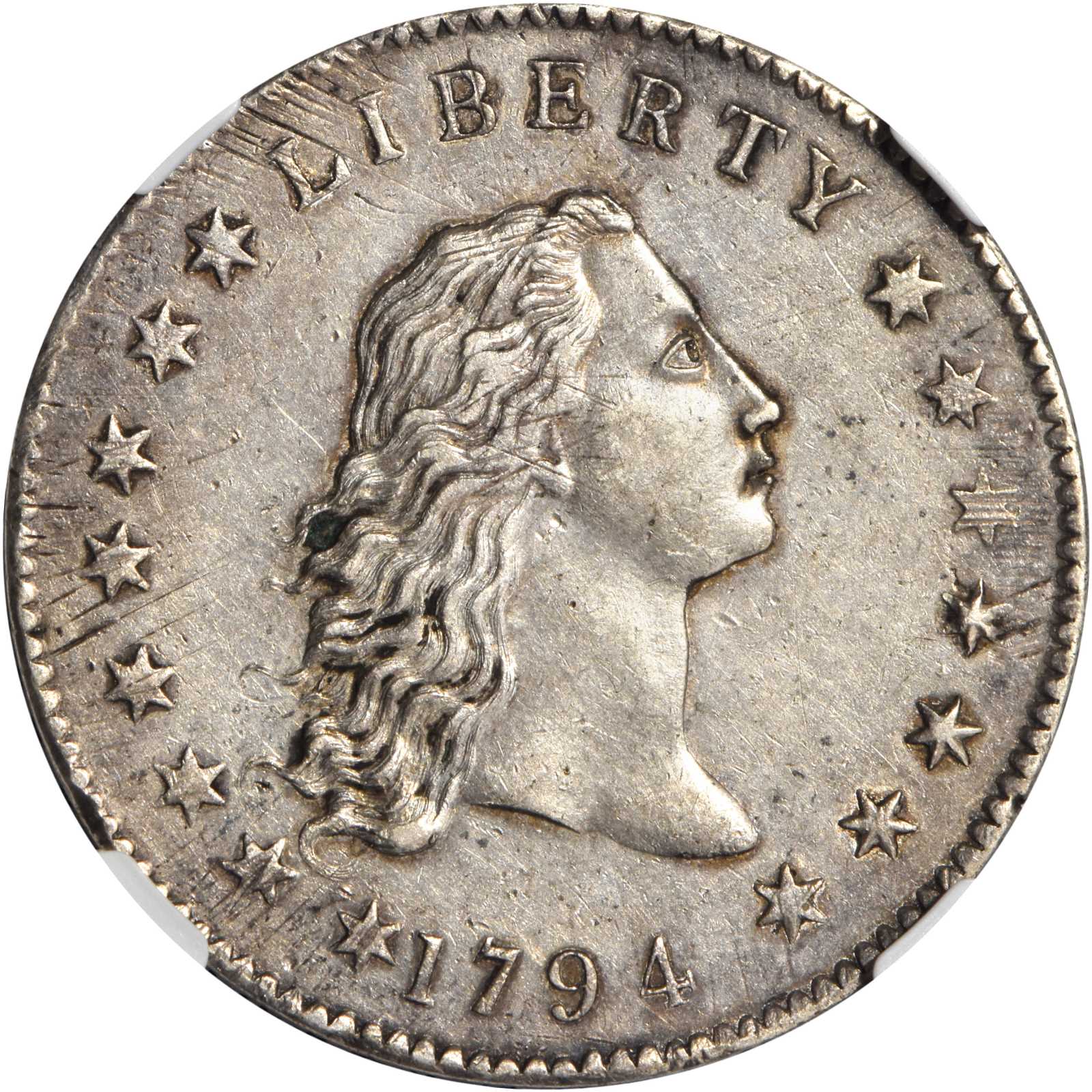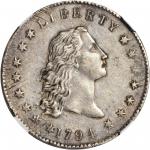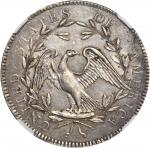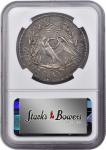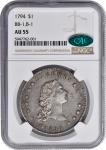1794 Flowing Hair Silver Dollar. BB-1, B-1, the only known dies. Rarity-4. AU-55 (NGC). CAC. The silver dollar was authorized by the Act of April 2, 1792, that also established the United States Mint and created our nations coinage. While not the highest denomination coin authorized by that act, the silver dollar was obviously the most important, as it was the standard unit upon which the United States monetary system would be based. All other coins struck in the United States Mint from the 1790s to the present day are either fractional parts of the dollar or multiples of that unit. The silver dollar is, without a doubt, the most popular and widely collected coin ever struck in the United States Mint, and is eagerly sought as a historic treasure, a cherished collectible and (for common date examples of the later Morgan and Peace types) a storehouse of wealth for those interested in owning silver bullion.
The most important silver dollar ever struck - and also one of the rarest - is the 1794 Flowing Hair. The first of its kind and a famous numismatic rarity in all grades with a mintage of just 1,758 pieces, the 1794 Flowing Hair silver dollar is a coin of which legends are made. Eager anticipation greets survivors when they are offered for sale either through auction or via private treaty. Such is the importance and popularity of the 1794 Flowing Hair dollar that it has been honored with the No. 3 ranking in the fifth edition (2019) of the popular and influential reference <em>100 Greatest U.S. Coins</em> by Jeff Garrett and Ron Guth.
The design of the nations first silver dollar was entrusted to Chief Engraver Robert Scot, whose obverse features the most mature evolution of the Flowing Hair Liberty portrait that had been featured first on Augustin Dupres Libertas Americana medal of 1783. By the time Dupres Liberty found her way onto the silver dollar, however, she had been turned to the right and no longer displayed the liberty pole and cap. The basic design is superficially similar to its earliest inception, nonetheless, with Libertys hair free flowing along the back of her head and neck, thus explaining the widely used name. Scots dollar obverse also exhibits 15 stars around the border arranged eight left, seven right, in honor of the number of states that made up the Union in 1794. The word LIBERTY is at the upper border, and the date 1794 is at the lower.
The reverse of the Flowing Hair silver dollar mirrors Scots work for the Flowing Hair half dime and half dollar. A spread-wing eagle is surrounded by two branches bound at their base by a thin ribbon with the legend UNITED STATES OF AMERICA around the border. Curiously, the denomination is not featured on either the obverse or reverse of the Flowing Hair silver dollar - something that might appear as a sign of ineptitude on the part of early Mint employees to someone familiar with United States coinage of the 21st century. The omission was intentional, however, as United States coinage was new to the world market of the 18th century and the term "dollar" would have been unfamiliar to merchants of the day. In order to facilitate the coins acceptance in as many quarters as possible, the Mint omitted the denomination from the design and opted to let the silver dollars weight and precious metal content establish its value. For those willing to look closer, they would find the denomination on the edge, which is lettered HUNDRED CENTS ONE DOLLAR OR UNIT with decorations between the words.
By the time Mint employees had posted the necessary bonds to begin working with precious metals - which was not until 1794 even though the silver dollar had been authorized by Congress in 1792 - Mint Director David Rittenhouse wanted to begin production of these coins as soon as possible. His decision was a bold one, for the press he had on hand was better suited for striking smaller coins such as dimes, quarters and half dollars. In recognition of the silver dollars status as the basic unit of our national currency and the largest coin authorized by the Act of April 2, 1792, however, Rittenhouse insisted that it be the first precious metal coin struck in the United States Mint.
Difficulties in achieving Rittenhouses goal arose immediately because bullion was lacking. The early United States Mint did not strike silver and gold coins on its own account but, rather, was dependent upon private deposits of these precious metals. The first deposit of silver to arrive at the United States Mint came from the Bank of Maryland on July 18, 1794. Composed of French coins, Assayer Albion Coxs tests of the metals fineness averaged just .737 fine, meaning the deposit would have to be heavily refined to bring it up to the congressionally mandated .8924 standard for silver coinage. With the refining department understaffed, Rittenhouse made a bold choice: rather than follow the letter of the law, whereby depositors received finished coins based upon the order of their initial deposits, Rittenhouse himself jumped the line. On August 29, 1794, he made two deposits, composed of silver ingots of relatively fine purity (.900 and .8665 fine) that added up to $2001.33 worth of silver, or enough to strike almost exactly 2,000 silver dollars.
On October 15, 1794, Chief Coiner Henry Voigt delivered 1,758 silver dollars to David Rittenhouse, representing the entire mintage for the year. The Mints workmen could have struck all of these coins in a single afternoon, using a press ill-suited for the rigors of striking the large diameter dies. Rittenhouse later received $242.50 in half dollars, plus six half dimes, to complete the total initial deposit, but according to traditional numismatic wisdom the original mintage of 1794 dollars amounted to 2,000 coins. Proponents of this theory believe that the remaining 242 examples were judged to be underweight and/or too poorly struck to be released, the coins either remelted or used as planchets for 1795-dated silver dollars. At least one poorly struck 1794 dollar was used as a planchet for a 1795 dollar, but since that coins discovery in the 1960s, no other examples have come to light. If the original mintage of the 1794 dollar was 2,000 pieces, the remaining 242 or so coins were almost certainly melted. Alternatively, the total mintage might be just 1,758 pieces, the failure of the press under the rigors of striking these large coins ending the days work prematurely and prompting the chief coiner to make up the balance of Rittenhouses bullion deposits in half dollars and half dimes, as related above. We will never know for sure because no details were recorded and no ceremony was held, despite the historical significance of the event.
Indeed, even those 1794 dollars that were deemed acceptable for distribution exhibit many of the coining difficulties suffered by the early United States Mint. Virtually all of the known examples are softly struck to one degree or another at the left obverse and reverse borders. This is due not only to the Mints use of a press that was intended for smaller-size coins, but also because the dies eventually "slipped" and became misaligned in the press. On some 1794 dollars the misalignment is so pronounced that the date can be difficult to discern. Additionally, many examples display adjustment marks that represent the Mints filing down of overweight planchets to make them conform to the legally specified weight range for this issue. While these adjustment marks are often innocuous, they are sometimes so numerous as to severely compromise one or more elements of a coins design.
Regardless of striking quality or level of preservation, any 1794 Flowing Hair silver dollar is an extremely important numismatic find, and the ownership of even a low grade or impaired example is the mark of an important collection. Writing in the 2010 edition of the reference <em>The Flowing Hair Silver Dollars of 1794: An Historical and Population Census Study</em>, Martin Logies of the Cardinal Collection Educational Foundation accounts for a surviving population of 140 to 150 examples. This estimate is mirrored by the figure of "Est. 150 known" provided by <em>PCGS CoinFacts</em>, while Q. David Bowers (<em>The Encyclopedia of United States Silver Dollars: 1794-1804</em>, 2013) agrees with both of these other sources when he says that 135 to 150 examples are extant. These estimates represent a rather high percentage of the mintage based upon most statistical survivorship models of early American coins. This high percentage reflects the early date at which collectors placed a premium on 1794 dollars, thus saving low grade specimens that would have been consigned to the melting pot if they were of any other date. Indeed, many of the known examples are significantly impaired due to cleaning, repairs, edge damage, or other problems.
Even most problem free 1794 Flowing Hair dollars that have survived did so only after acquiring some degree of wear. Indeed, in Mint State this issue is a landmark rarity. Exactly how many Uncirculated 1794 dollars exist is a matter of debate as fluctuating grading standards over the years have resulted in some specimens alternating between About Uncirculated and Mint State grades. The finest is unequivocally the Neil-Carter-Contursi specimen certified Specimen-66 by PCGS that Stacks Bowers Galleries sold for the record-setting price, at that time, of $10,016,875 in our January 2013 Cardinal Collection sale. The 2010 Logies census lists five Mint State coins behind the Specimen-66 example, a total that must be increased to six due to the certification of the Austrian-Whittlin-Willing specimen as NGC MS-62 when it realized $1,050,000 in our December 2020 sale of the Larry H. Miller Collection. Whereas the aforementioned 2010 edition of the Logies reference provided detailed provenance listings for only the top 12 examples known to the author at that time, the earlier 2004 edition of his book documented (with images in most cases) 125 distinct 1794 dollars ranging from the Neil-Carter-Contursi specimen in PCGS Specimen-66 to a coin in Good-6. The list of examples documented by Logies had increased to 136 by 2010, albeit without detailed provenances provided in print for any examples grading below AU.
The coin offered here is not listed in either edition of the Logies 1794 dollar reference and, given the manner in which it has entered the modern numismatic market, we believe that it is a newcomer to the census. Logies accounts for such new discoveries, of course, with this comment in the 2010 edition of his book:
<em>"136 distinct specimens have been documented to exist, with some number of undocumented (or incompletely documented) specimens also likely, suggesting a total population of approximately 140 to 150 specimens."</em>
The authors 2010 census includes 12 coins in various AU grades, four of which are impaired. As a problem free and thoroughly appealing Choice AU-55 certified by NGC, and verified by CAC, this newly confirmed specimen qualifies as CC#10 based on that listing.
This remarkable coin is very well struck and remarkably well preserved for the issue. Dollars of this date often display soft to blunt detail along the left obverse and reverse borders due to the misalignment of the dies in the press. For the present example, however, we note nearly complete denticulation around both sides. Only from 10 to 11 oclock on the obverse does the detail to the denticulation come up a bit short, but minimally so and hardly significant. All but one of the 15 stars are boldly to sharply rendered, all four digits in the date are bold and clear, and the word LIBERTY is fully legible. The reverse features a fully legible legend UNITED STATES OF AMERICA, a touch of softness to the top of the letters TED STA along the left border is noted solely for accuracy. Both sides are boldly to sharply struck in and around the centers with only the lightest rub to the high points appropriate for the AU-55 grade returned by NGC.
The often-seen adjustment marks (as made) are barely in evidence here, there being only traces around the obverse border, most prominently at 3, 7, 9 and 11 oclock, those in the first-listed area having the only significant effect on the detail and explaining the bluntness to star 11. The reverse is free of adjustment marks, as are the centers on both sides. Satiny surfaces are lightly and evenly toned in pewter-gray with a few tiny, ancient carbon spots scattered about that find their greatest concentration at the top of the eagles left wing. An ancient green deposit is nestled within the top two highest locks of hair along the back of Libertys portrait -- a potentially useful identifier for tracking this coin in future market appearances. There are no significant handling marks, an unusual feature for this rare issue from the earliest days of the U.S. Mint. There are faint traces of the original mint finish, as well as subtle powder blue and champagne-gold undertones, both features enhancing the eye appeal. BB Die State I, with no clash marks on either side and the ends of Libertys hair locks extending quite boldly into the left obverse field.
A leading highlight of this sale, here is an exceptional and significant 1794 dollar making its exciting debut at auction. It is sure to attract spirited bidding from advanced type collectors, early dollar enthusiasts, and other numismatists who appreciate the historical significance and well known rarity of this issue. Acquired by a southern United Kingdom dealer in an accumulation, circa 1996; submitted to Stacks Bowers Galleries for evaluation during the COVID-19 lockdown; recently certified for the first time by NGC and also seen for the first time by CAC.

